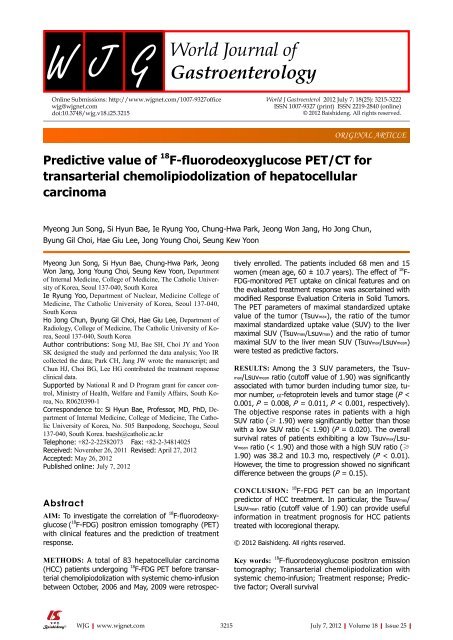Ghrelin's second life - World Journal of Gastroenterology
Ghrelin's second life - World Journal of Gastroenterology
Ghrelin's second life - World Journal of Gastroenterology
Create successful ePaper yourself
Turn your PDF publications into a flip-book with our unique Google optimized e-Paper software.
Online Submissions: http://www.wjgnet.com/1007-9327<strong>of</strong>fice<br />
wjg@wjgnet.com<br />
doi:10.3748/wjg.v18.i25.3215<br />
Predictive value <strong>of</strong> 18 F-fluorodeoxyglucose PET/CT for<br />
transarterial chemolipiodolization <strong>of</strong> hepatocellular<br />
carcinoma<br />
Myeong Jun Song, Si Hyun Bae, Ie Ryung Yoo, Chung-Hwa Park, Jeong Won Jang, Ho Jong Chun,<br />
Byung Gil Choi, Hae Giu Lee, Jong Young Choi, Seung Kew Yoon<br />
Myeong Jun Song, Si Hyun Bae, Chung-Hwa Park, Jeong<br />
Won Jang, Jong Young Choi, Seung Kew Yoon, Department<br />
<strong>of</strong> Internal Medicine, College <strong>of</strong> Medicine, The Catholic University<br />
<strong>of</strong> Korea, Seoul 137-040, South Korea<br />
Ie Ryung Yoo, Department <strong>of</strong> Nuclear, Medicine College <strong>of</strong><br />
Medicine, The Catholic University <strong>of</strong> Korea, Seoul 137-040,<br />
South Korea<br />
Ho Jong Chun, Byung Gil Choi, Hae Giu Lee, Department <strong>of</strong><br />
Radiology, College <strong>of</strong> Medicine, The Catholic University <strong>of</strong> Korea,<br />
Seoul 137-040, South Korea<br />
Author contributions: Song MJ, Bae SH, Choi JY and Yoon<br />
SK designed the study and performed the data analysis; Yoo IR<br />
collected the data; Park CH, Jang JW wrote the manuscript; and<br />
Chun HJ, Choi BG, Lee HG contributed the treatment response<br />
clinical data.<br />
Supported by National R and D Program grant for cancer control,<br />
Ministry <strong>of</strong> Health, Welfare and Family Affairs, South Korea,<br />
No. R0620390-1<br />
Correspondence to: Si Hyun Bae, Pr<strong>of</strong>essor, MD, PhD, Department<br />
<strong>of</strong> Internal Medicine, College <strong>of</strong> Medicine, The Catholic<br />
University <strong>of</strong> Korea, No. 505 Banpodong, Seochogu, Seoul<br />
137-040, South Korea. baesh@catholic.ac.kr<br />
Telephone: +82-2-22582073 Fax: +82-2-34814025<br />
Received: November 26, 2011 Revised: April 27, 2012<br />
Accepted: May 26, 2012<br />
Published online: July 7, 2012<br />
Abstract<br />
AIM: To investigate the correlation <strong>of</strong> 18 F-fluorodeoxyglucose<br />
( 18 F-FDG) positron emission tomography (PET)<br />
with clinical features and the prediction <strong>of</strong> treatment<br />
response.<br />
METHODS: A total <strong>of</strong> 83 hepatocellular carcinoma<br />
(HCC) patients undergoing 18 F-FDG PET before transarterial<br />
chemolipiodolization with systemic chemo-infusion<br />
between October, 2006 and May, 2009 were retrospec-<br />
WJG|www.wjgnet.com<br />
<strong>World</strong> J Gastroenterol 2012 July 7; 18(25): 3215-3222<br />
ISSN 1007-9327 (print) ISSN 2219-2840 (online)<br />
© 2012 Baishideng. All rights reserved.<br />
tively enrolled. The patients included 68 men and 15<br />
women (mean age, 60 ± 10.7 years). The effect <strong>of</strong> 18 F-<br />
FDG-monitored PET uptake on clinical features and on<br />
the evaluated treatment response was ascertained with<br />
modified Response Evaluation Criteria in Solid Tumors.<br />
The PET parameters <strong>of</strong> maximal standardized uptake<br />
value <strong>of</strong> the tumor (Tsuvmax), the ratio <strong>of</strong> the tumor<br />
maximal standardized uptake value (SUV) to the liver<br />
maximal SUV (Tsuvmax/Lsuvmax) and the ratio <strong>of</strong> tumor<br />
maximal SUV to the liver mean SUV (Tsuvmax/Lsuvmean)<br />
were tested as predictive factors.<br />
RESULTS: Among the 3 SUV parameters, the Tsuvmax/Lsuvmean<br />
ratio (cut<strong>of</strong>f value <strong>of</strong> 1.90) was significantly<br />
associated with tumor burden including tumor size, tumor<br />
number, α-fetoprotein levels and tumor stage (P <<br />
0.001, P = 0.008, P = 0.011, P < 0.001, respectively).<br />
The objective response rates in patients with a high<br />
SUV ratio (≥ 1.90) were significantly better than those<br />
with a low SUV ratio (< 1.90) (P = 0.020). The overall<br />
survival rates <strong>of</strong> patients exhibiting a low Tsuvmax/Lsuvmean<br />
ratio (< 1.90) and those with a high SUV ratio (≥<br />
1.90) was 38.2 and 10.3 mo, respectively (P < 0.01).<br />
However, the time to progression showed no significant<br />
difference between the groups (P = 0.15).<br />
CONCLUSION: 18 F-FDG PET can be an important<br />
predictor <strong>of</strong> HCC treatment. In particular, the Tsuvmax/<br />
Lsuvmean ratio (cut<strong>of</strong>f value <strong>of</strong> 1.90) can provide useful<br />
information in treatment prognosis for HCC patients<br />
treated with locoregional therapy.<br />
© 2012 Baishideng. All rights reserved.<br />
ORIGINAL ARTICLE<br />
Key words: 18 F-fluorodeoxyglucose positron emission<br />
tomography; Transarterial chemolipiodolization with<br />
systemic chemo-infusion; Treatment response; Predictive<br />
factor; Overall survival<br />
3215 July 7, 2012|Volume 18|Issue 25|

















